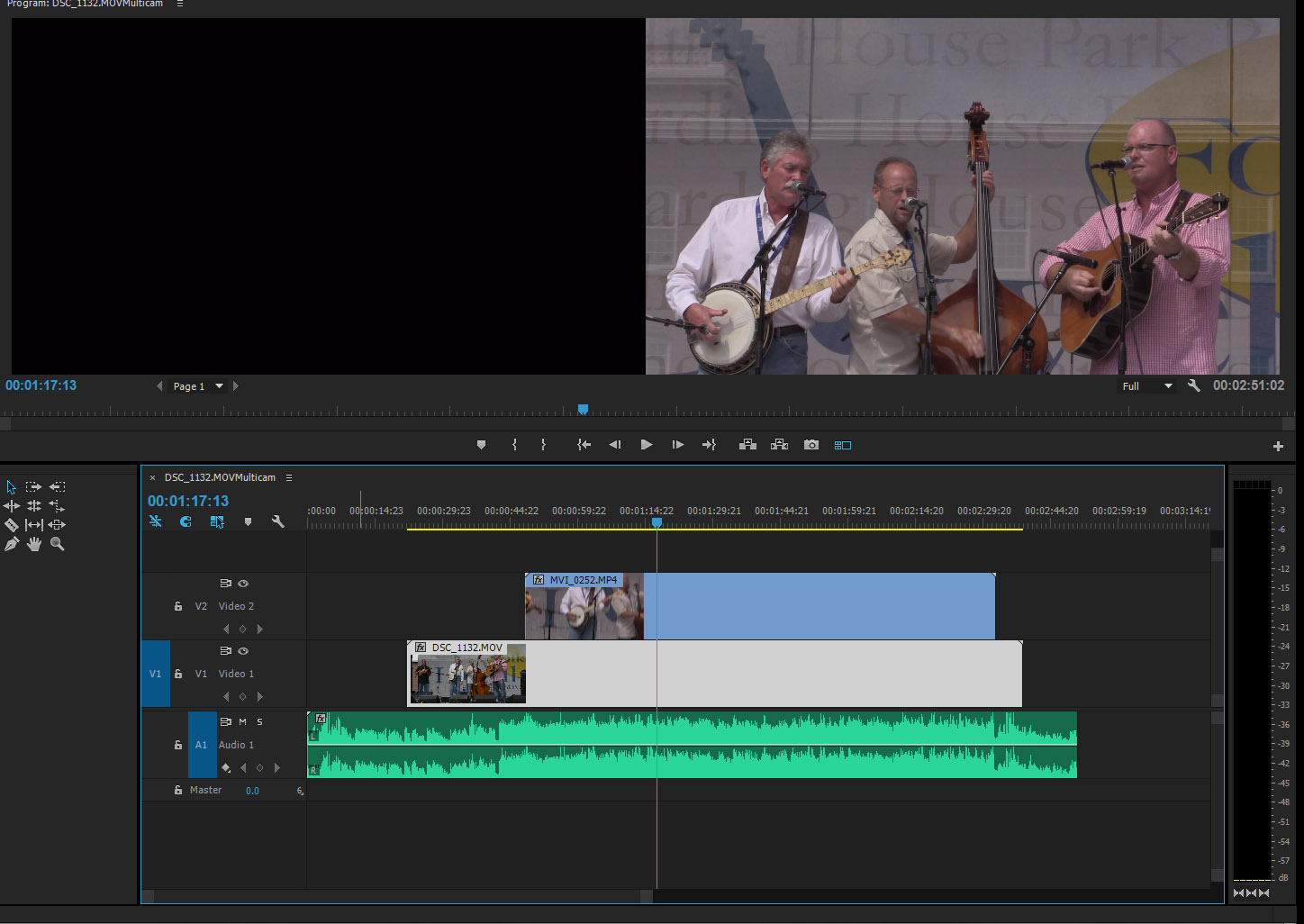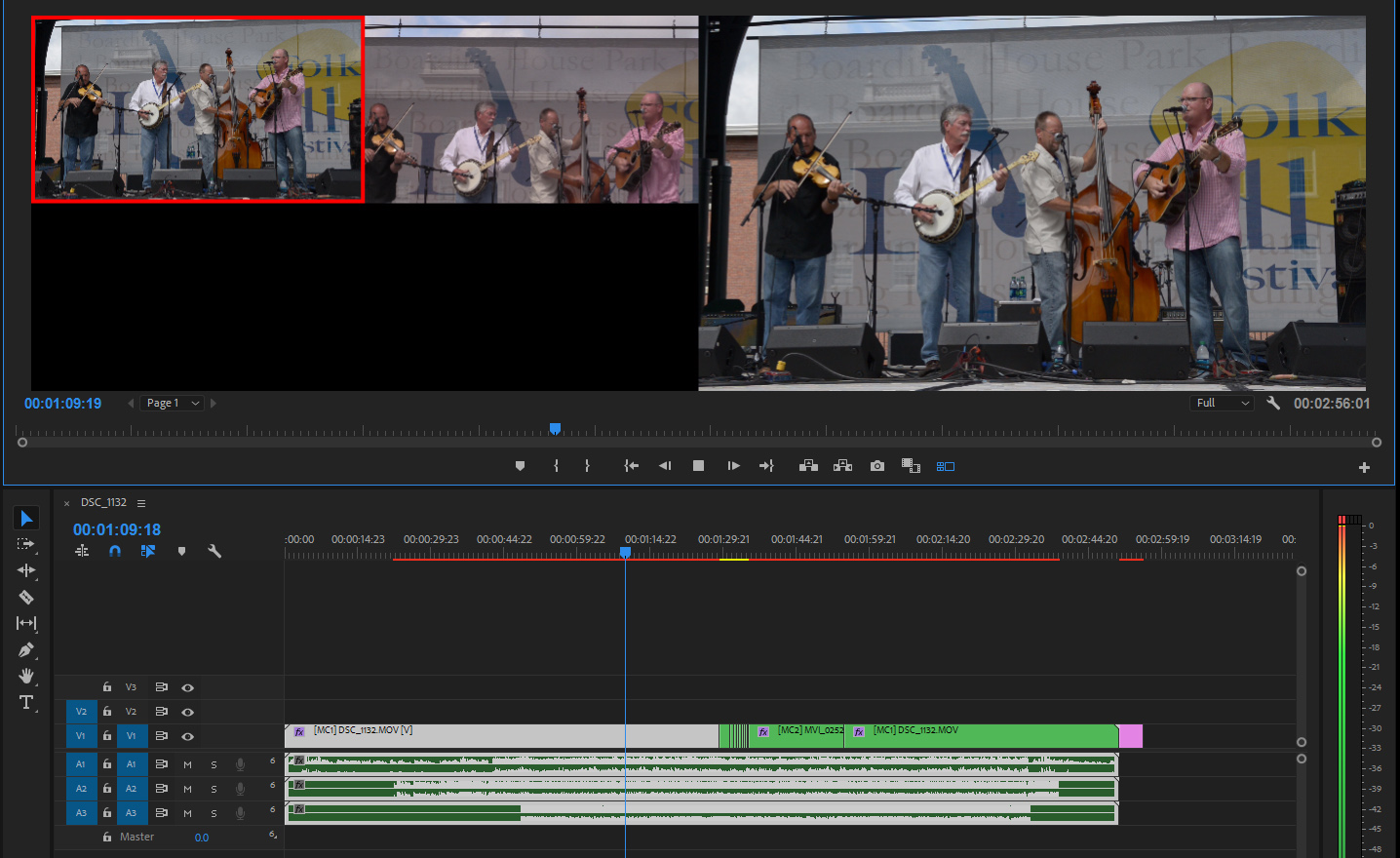- Inicio
- Premiere Pro
- Hilos de conversación
- Re: What is this kind of video track called? (term...
- Re: What is this kind of video track called? (term...
Copiar vínculo al Portapapeles
Copiado
I want to know the correct term to use when talking to other Premiere Pro users for something.
If I import some video content, say some MP4 files from my videocam or my phone, and then place them on the timeline, each video track represents one track of video. I can think of each track like a videotape or a strip of movie film - at any given point in time there is a particular image for that track. If there's more than one track at a given point in time the actual image you see in the monitor will depend on what's enabled and various masking, blending and other settings but for any specific track there's a specific image.

But If I'm doing multi-camera editing and I do a New Sequence From Clip I get one track but there could be multiple camera angles represented at any one point on the timeline for that one track (V1 in this case)...

What you see in the monitor depends on what selections or cuts you make but they're all still there on V1 - you could move your cut - essentially changing the in/out point - and reveal another camera angle on that same track. I've been using the term "composite track" to refer to one of these multi-angle tracks but someone on another website said that has another formal meaning in some older version of Premiere Pro. So what is the Adobe canonically-correct term for this kind of a track, when you're talking to other Premiere users?
Thanks in advance.
 1 respuesta correcta
1 respuesta correcta
There is no unique terminology that I'm aware of, and I've been editing since 1992 and using Premiere since v6.0 a long time ago. They are not different kinds of video tracks. You are editing using the MultiCam feature in Premiere, or not.
Thanks
Jeff
Copiar vínculo al Portapapeles
Copiado
I'll be anxious to hear what replies you get to this, Peter. I like the term you used, "composite" track - because it's got a lot going on in it, including the cut points for the various cameras. I saw the term "multicam toast" the other day, and it made sense - a single piece of bread with some butter and possibly other things on top. But I don't know how official that term is! ![]() Thanks for asking the important questions here. Like you, I want to be canonically-correct. There are lots of pros on the forum, let's see how they weigh in!
Thanks for asking the important questions here. Like you, I want to be canonically-correct. There are lots of pros on the forum, let's see how they weigh in!
Copiar vínculo al Portapapeles
Copiado
Hi peternelson
I'm not an industry video professional but use video quite a bit in educational contexts. With that disclaimer, I haven't heard the term 'composite track' used in the official reference to what you're specifying. I have heard of the term multi-camera sequence or multi-camera source sequence.
Copiar vínculo al Portapapeles
Copiado
It is a "multi-camera target sequence."
Create and edit a multi-camera sequence in Premiere Pro
That said, you'll see threads that illustrate how many different terms may be used to refer to this.
As to how "composite" is used, do a search of the PR help files. Many different contexts.
Edit:
In support of your concept that the multi-camera target sequence is a type of "composite track," see help re "trim mode":
"All of the sequence's video tracks are composited together …."
Copiar vínculo al Portapapeles
Copiado
I don't have a name suggestion, sorry. But I do, just from personal preference/experience, offer an alternative workflow.
Rather than use MultiCam functionality, I've always just stacked my 2 or 3 source clips from different cameras on tracks V1, V2, and V3. Get them synced up of course using audio waveform or visual cue. Then unlink video and audio.
I put the most commonly used camera angle on top track. Second most-used camera on V2, then wide/cover shot on V1.
Now all I have to do is play or scrub through timeline, and when I don't like the "main" camera footage on V3, I do a quick cut and remove of the "bad" section, which then "reveals" the V2 video below in that area. If for some reason that footage is also undesirable, I can cut that to reveal V1 footage.
This has worked very well for me for wedding ceremonies and stage events like school musicals, dance recitals, etc.
I just figure I will want the MAIN camera (that is doing close-ups and following the action) to be visible most of the time, so that is top-most track, then I can just chop parts out and reveal other camera angles beneath as needed.
The MultiCam editing tool can have its place, but for the way I edit, not ideal - I like to be able to take a lot of cutaway shots, like crowd reactions, and move them around to different places in the timeline as filler, so I need manual control of all the bits and pieces of video clips in their original context, not boiled down to a single track.
So that's just my take on it, do what works for you
Thanks
Jeff
Copiar vínculo al Portapapeles
Copiado
I don't have a name suggestion, sorry. But I do, just from personal preference/experience, offer an alternative workflow.
I do both depending on the project. But that makes it even more important that I use the correct terminology to distinguish these two kinds of video tracks. I also do volunteer work with my local community TV station, and that could include editing in Premiere Pro, and I'm about to join a local filmmaking cooperative. So that's why I want to make sure I use the right terminology because I'll be communicating with others.
Copiar vínculo al Portapapeles
Copiado
There is no unique terminology that I'm aware of, and I've been editing since 1992 and using Premiere since v6.0 a long time ago. They are not different kinds of video tracks. You are editing using the MultiCam feature in Premiere, or not.
Thanks
Jeff
Copiar vínculo al Portapapeles
Copiado
I don't understand why you say they are not different kinds of video tracks. One kind holds images from just one camera - at any point in time there is exactly one frame that exists on that track. But the "composite"/"multicam" track represents all the cameras in the same track. It's like the difference between a file and a folder. One is a single thing, one is a collection of things. Am I thinking about this wrong?
Copiar vínculo al Portapapeles
Copiado
The name/label of the track itself doesn't change. The track itself does not behave any differently. It's the content of the clip in the track. For instance instead of dropping video clips into sequence, you can put another sequence into a sequence, and whatever edits/effects were in that original sequence will appear in the new nested sequence, but the track is still a track, that does not change.
Copiar vínculo al Portapapeles
Copiado
The Source Sequence contains the original media.
The Target Sequence contains the nested Source Sequence, and is where you make your multicam cuts.
